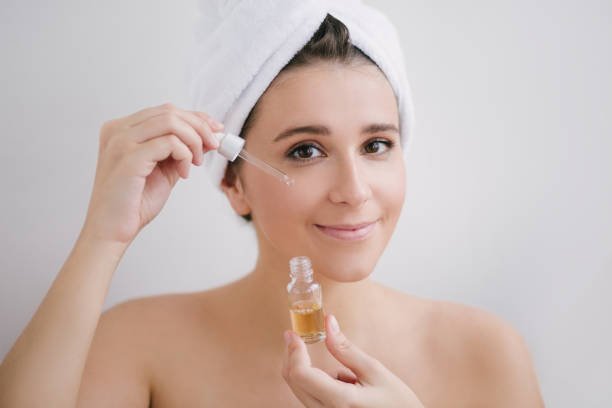Right Face Serum for Your Skin Type can greatly improve your skincare routine. With countless options available, understanding your skin type and specific concerns is vital for achieving the best results.
What Are Face Serums?

Face serums are concentrated formulations designed to target specific skin issues. They typically feature a lightweight texture, allowing deeper skin penetration than heavier creams. These serums often contain various active ingredients, such as vitamins, antioxidants, and botanical extracts, each aimed at addressing particular concerns.
Benefits of Using a Serum
- Targeted Treatment: Serums are specifically formulated to tackle various skin problems, including acne, signs of aging, and uneven pigmentation.
- High Concentration of Active Ingredients: Due to their concentrated nature, serums often boast higher levels of powerful ingredients compared to regular moisturizers.
- Quick Absorption: Their lightweight formulation allows for rapid absorption, providing effective results more efficiently.
Identifying Your Skin Type
Before selecting a serum, it’s crucial to determine your skin type. Here’s an overview of common skin types and their characteristics:
1. Oily Skin
- Characteristics: Shiny surface, enlarged pores, and a tendency to experience breakouts.
- Common Concerns: Acne, blackheads, and excess oil production.
2. Dry Skin
- Characteristics: Flaky or rough texture, tightness, and a dull appearance.
- Common Concerns: Dehydration, fine lines, and increased sensitivity.
3. Combination Skin
- Characteristics: A blend of oily and dry areas, often featuring an oily T-zone (forehead, nose, chin) with normal or dry cheeks.
- Common Concerns: Balancing moisture and controlling oil levels.
4. Sensitive Skin
- Characteristics: Easily irritated, prone to redness, and reactive to products.
- Common Concerns: Allergies, inflammation, and dryness.
5. Mature Skin
- Characteristics: Decreased elasticity, visible fine lines, and uneven skin tone.
- Common Concerns: Age spots, wrinkles, and sagging.
Choosing the Right Serum for Your Skin Type
For Oily Skin
Recommended Ingredients:
- Niacinamide: Regulates oil production and minimizes the appearance of pores.
- Salicylic Acid: A beta hydroxy acid that penetrates pores to help clear excess oil and dead skin.
- Tea Tree Oil: Known for its antibacterial properties, it can assist in reducing breakouts.
Best Practices:
- Opt for gel-based or lightweight serums that absorb quickly.
- Avoid heavy oils or thick creams that could worsen oiliness.
For Dry Skin
Recommended Ingredients:
- Hyaluronic Acid: A potent humectant that attracts moisture to the skin.
- Glycerin: Draws moisture from the environment, keeping the skin hydrated.
- Squalane: A natural moisturizer that helps prevent water loss and improves skin texture.
Best Practices:
- Choose serums with a rich, emollient texture.
- Layer your serum beneath a moisturizer for enhanced hydration.
For Combination Skin
Recommended Ingredients:
- Rosehip Oil: Balances hydration while improving skin texture.
- Aloe Vera: Soothes and hydrates without adding heaviness.
- Lactic Acid: A gentle exfoliant that hydrates while enhancing skin tone.
Best Practices:
- Use a serum that effectively addresses both oily and dry areas.
- Consider applying different serums to different parts of your face as needed.
For Sensitive Skin
Recommended Ingredients:
- Chamomile: Renowned for its calming and soothing properties.
- Centella Asiatica: Aids in repairing the skin barrier and reducing inflammation.
- Zinc: Supports healing and lessens irritation.
Best Practices:
- Choose fragrance-free, hypoallergenic serums.
- Always conduct a patch test with new products to avoid adverse reactions.
For Mature Skin
Recommended Ingredients:
- Vitamin C: An antioxidant that brightens the complexion and addresses pigmentation.
- Peptides: Stimulate collagen production, improving skin firmness and elasticity.
- Retinol: A vitamin A derivative that diminishes fine lines and enhances skin texture.
Best Practices:
- Select serums with anti-aging properties to address visible signs of aging.
- Incorporate your serum into your nighttime routine, especially those with retinol.
How to Incorporate Serums into Your Skincare Routine

Step-by-Step Application
- Cleanse: Start with a gentle cleanser to remove impurities.
- Tone (Optional): Use a toner to prepare your skin for better serum absorption.
- Apply Serum: Dispense a few drops and gently pat onto your face and neck.
- Moisturize: Follow with a moisturizer to seal in the serum’s benefits.
- Sunscreen (Morning Routine): Always finish with SPF during the day to protect your skin.
Tips for Optimal Results
- Layering: Allow the serum to absorb completely before applying additional products.
- Consistency: Use your serum regularly for best results; many serums require weeks to show noticeable effects.
- Storage: Keep your serum in a cool, dark place to maintain its effectiveness.
Common Mistakes to Avoid
- Ignoring Your Skin Type: Choosing a serum that doesn’t align with your skin type can lead to irritation or ineffectiveness.
- Overusing Products: Applying too many serums can overwhelm your skin; focus on one or two targeted products.
- Neglecting Patch Testing: Always test new products on a small area to identify any adverse reactions.
Conclusion
Selecting the right face serum that suits your skin type can enhance your skincare routine. By understanding your skin’s specific needs and concerns, you can choose a serum that effectively addresses them. Remember to apply your serum consistently, and you’ll be on your way to achieving healthier, more radiant skin. Enjoy your skincare journey!

